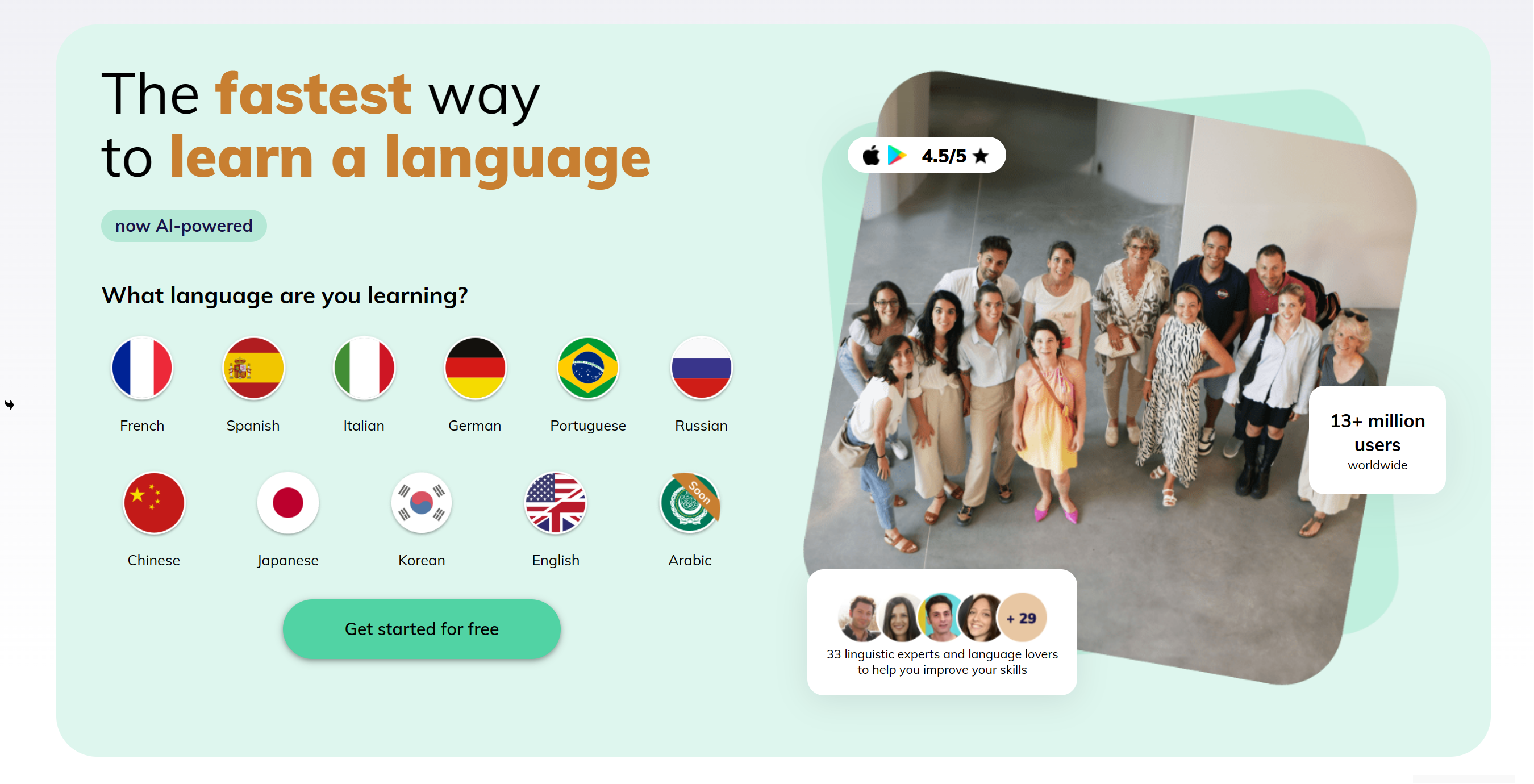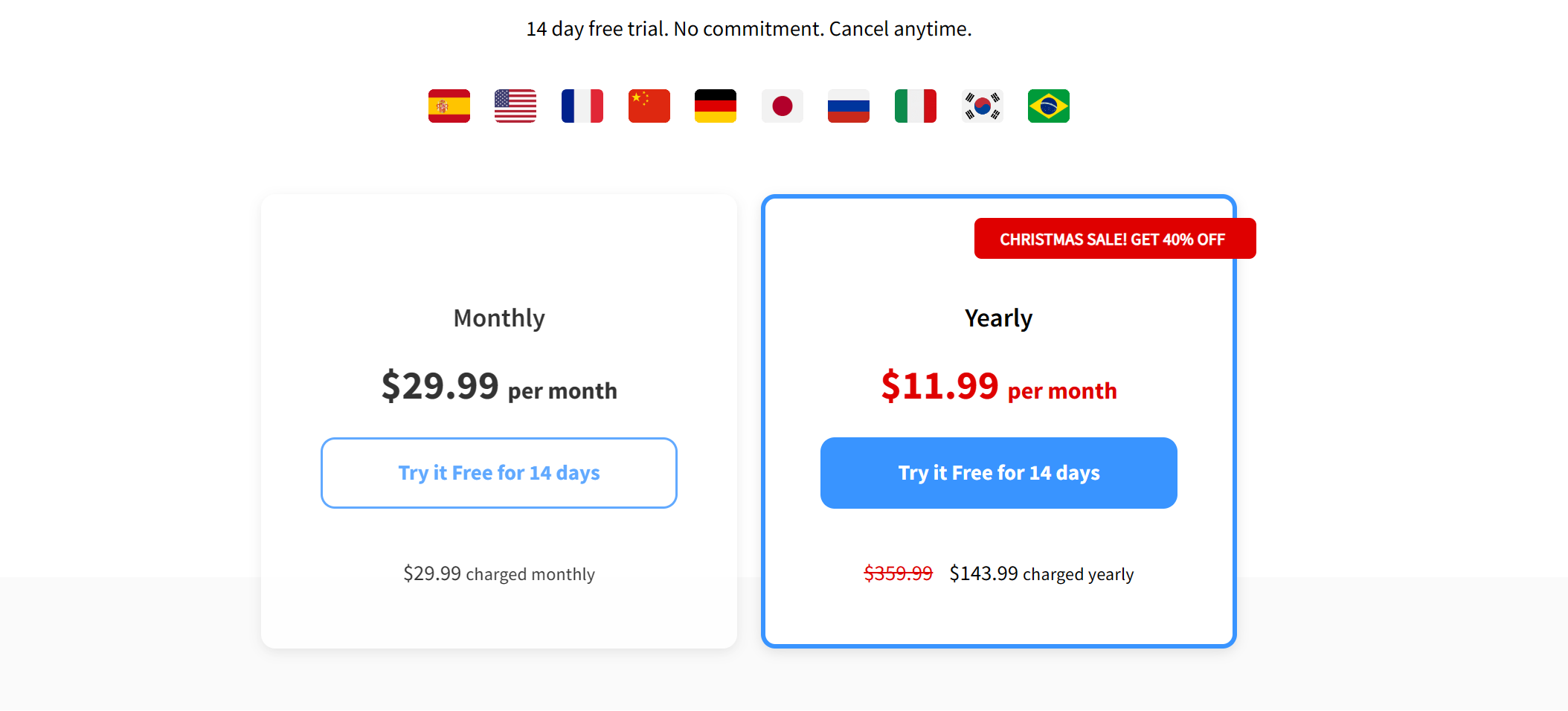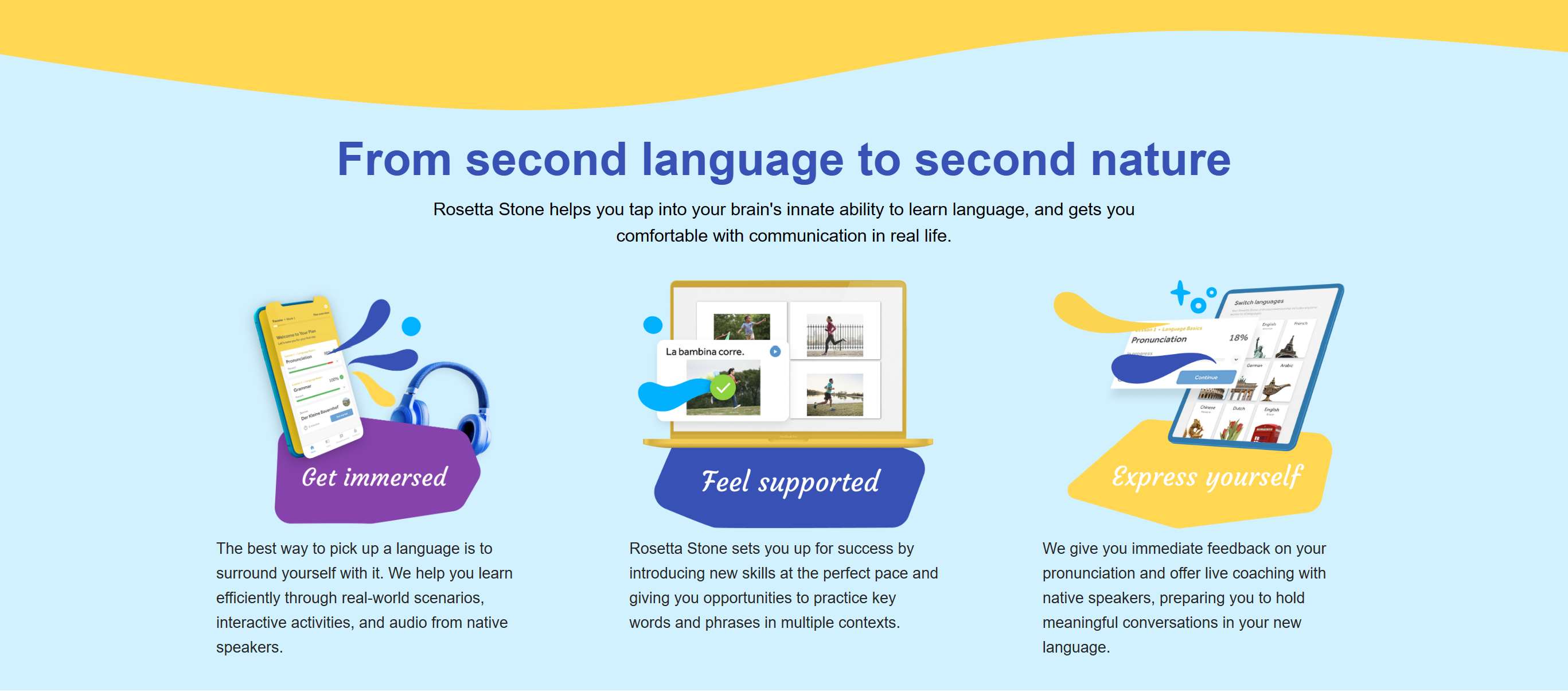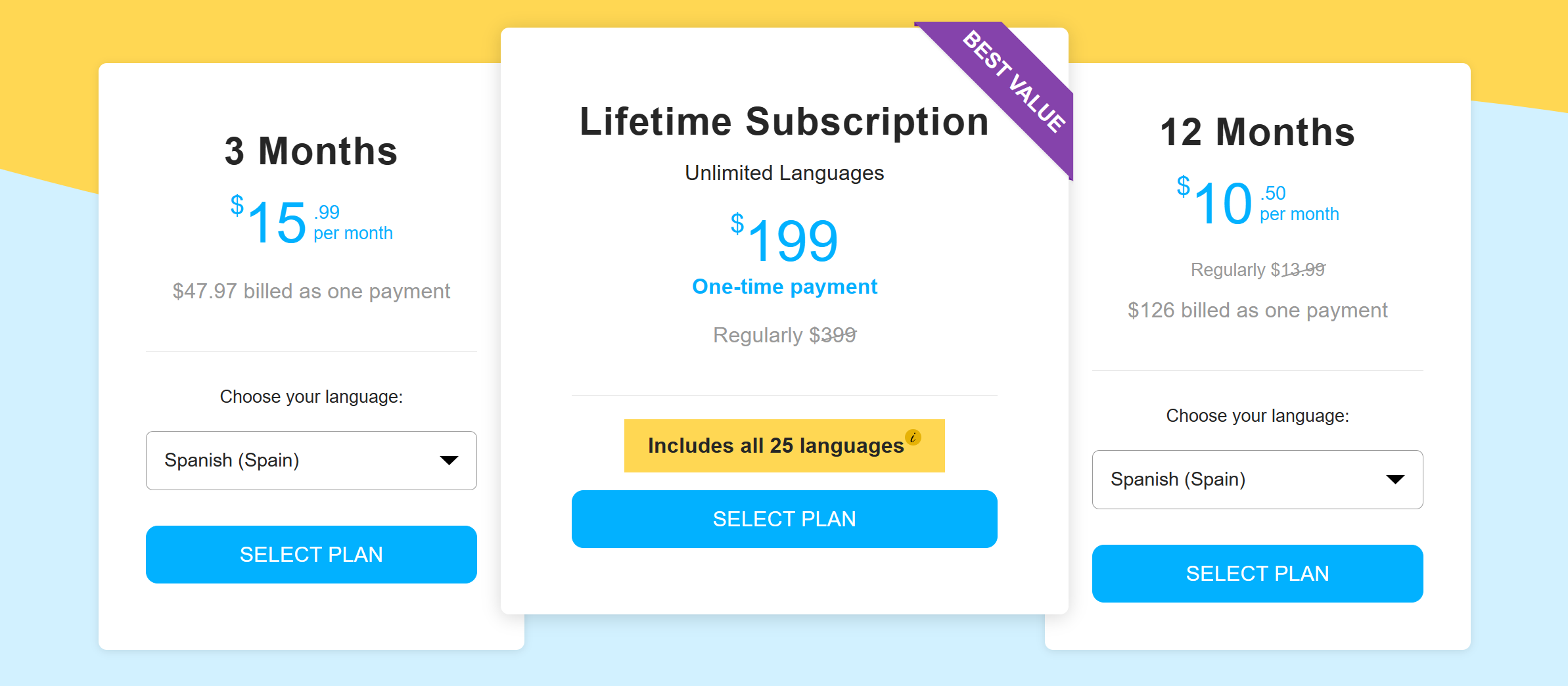Contents
Have you ever dreamt of speaking Spanish like a native? Imagine conversing fluently on the sunny streets of Barcelona or navigating through a charming Mexican marketplace with ease.
With today’s best Spanish learning apps, this dream can become your reality! These apps captivate your attention with interactive lessons, spark your interest with real-life scenarios, create a strong desire to learn with customizable learning paths and call you to action with daily practice goals.
Start your journey today and unlock a world where Spanish becomes a part of your everyday life!
I Tried These Apps To Learn Spanish. They Are Easy and Fun to Use.
| Feature | Duolingo | FluentU | Rosetta Stone | MosaLingua | Cudu |
|---|---|---|---|---|---|
| Learning Methodology | Gamified lessons with challenges | Real-world video content | Total immersion without translation | Spaced repetition with flashcards | Gamified conversations |
| Unique Content | Duolingo Stories with interactive plots | Real-world video content | TruAccent speech recognition | Vocabulary and phrases selection | Dialogues from popular movies |
| Pronunciation Practice | Voice recognition for pronunciation | Interactive subtitles | TruAccent speech recognition | Voice recognition for speaking | Voice recognition with challenges |
| Cultural Insights | Limited cultural context | Insights into culture and idioms | Limited cultural content | Focus on language and culture | Limited cultural context |
| Offline Learning | Limited offline access | Offline access available | Limited offline access | Offline access available | Limited offline access |
| Pricing Model | Freemium with subscription options | Subscription-based | Subscription-based | One-time payment | Freemium with subscription options |
| Live Tutoring Sessions | Not available | Not available | Available | Not available | Not available |
| Personalized Learning Path | Customized learning paths | Limited customization options | Personalized learning paths | Custom learning paths | Limited customization options |
Duolingo
As I’ve personally used Duolingo for learning Spanish, and it’s been a game-changer. Duolingo is incredibly user-friendly and makes learning feel like playing a game.
Its lessons are bite-sized, perfect for fitting into a busy schedule. What I loved most were the interactive exercises that helped reinforce my learning through repetition and fun challenges. The app also cleverly uses streaks and points to keep you motivated daily.
Another standout feature is the way Duolingo gradually builds your vocabulary and grammar skills, starting from basic words to more complex sentences. Plus, it’s free, which is fantastic for anyone wanting to learn without spending a lot.
If you’re exploring more options beyond Duolingo for language learning, don’t miss our comprehensive guide on the 6+ Best Duolingo Alternatives Dive in to find the perfect app that suits your learning style and goals.”
Overall, Duolingo’s engaging, flexible approach made my Spanish learning journey enjoyable and effective.
Four Unique Features That Make Duolingo the Best for Learning Spanish
Customized Learning Paths: What struck me first was how Duolingo tailored the learning experience to my level and goals. It felt like having a personal tutor, guiding me through a curriculum designed just for me.
Interactive Duolingo Stories: I was particularly impressed by the Duolingo Stories. These engaging, culturally rich narratives not only boosted my comprehension but also brought the language to life in a way that textbooks can’t.
Advanced Speaking Practice: The voice recognition for speaking exercises is a game-changer. It’s like having a language coach who corrects my pronunciation on the spot, helping me speak more confidently.
Social Features with Clubs and Leaderboards: The social aspect was a pleasant surprise. Joining clubs and competing on leaderboards made learning Spanish not just a solitary journey but a shared, fun experience with learners worldwide.
Quick Links:
- Busuu Vs Duolingo: Which Is Best For Language Learning?
- Pimsleur Spanish Review: Is It Worthy Or Hype?
Room for Growth: My Take on Two Areas Where Duolingo Could Improve
Limited Advanced Content: As I progressed to higher levels of Spanish, I found the content in Duolingo somewhat limiting. For advanced learners, the lessons can feel repetitive and don’t delve deep enough into complex grammar or nuanced conversation skills. I often wished for more challenging material to stretch my abilities further.
Inadequate Cultural Depth: While Duolingo is great for learning vocabulary and grammar, I felt it lacked in providing a deeper cultural context. Understanding the cultural nuances and idiomatic expressions of a language is crucial, and I think Duolingo could enrich its curriculum by integrating more of these aspects into its lessons.
How Much Does It Cost?
Learning Spanish Is Free In Duolingo (0$)
FluentU
Having personally used FluentU for learning Spanish, I found it a unique and immersive experience. FluentU stands out by using real-world videos like music videos, movie trailers, news, and inspiring talks, turning them into personalized language learning lessons.
What impressed me most was the authentic content; it felt like I wasn’t just learning a language, but also experiencing the culture directly.
The interactive subtitles were a highlight – I could tap on any word to see an image, definition, and usage examples.
This feature made understanding and remembering new words much easier. Additionally, FluentU’s quizzes, which are tailored to each video, reinforced my learning effectively.
Overall, FluentU offered a more natural way of learning Spanish, deeply rooted in the context of everyday use.
Four Unique Features That Make Duolingo the Best for Learning Spanish
Real-World Video Content: FluentU’s use of authentic video content, like news clips, music videos, and movie snippets, was a game-changer for me. This approach provided a real-world context that made learning not just about language, but also about the culture and current affairs.
Interactive Subtitles: The interactive subtitles on these videos were incredibly helpful. I could click on any word in the subtitles to see its meaning, usage, and related images. This made understanding new vocabulary more intuitive and memorable.
Personalized Quizzes: After each video, FluentU offered personalized quizzes. These weren’t generic fill-in-the-blanks but tailored to the content I had just watched, reinforcing my learning in a relevant and engaging way.
Spaced Repetition System (SRS): FluentU’s SRS for vocabulary was a standout. It ensured that I reviewed words at optimal intervals, significantly improving my retention. Unlike other apps where I often forgot words after a while, FluentU’s system helped me remember them long-term.
Room for Growth: My Take on Two Areas Where Duolingo Could Improve
User Interface and Navigation: One of the challenges I faced was navigating through the FluentU app. The user interface, though clean, can sometimes be less intuitive, especially for beginners. I often found myself struggling to find specific features or return to a particular lesson. A more streamlined and user-friendly interface would enhance the overall learning experience.
Limited Beginner Material: As someone who started with a basic level of Spanish, I noticed that FluentU seems more geared toward intermediate and advanced learners. The real-world videos are engaging, but they can be overwhelming for beginners due to the pace and complexity of the language used. Incorporating more content tailored for absolute beginners, with simpler vocabulary and slower speech, would make FluentU more accessible to learners at all levels.
How Much Does It Cost?
| Plan | Price | Billing Frequency | Free Trial Duration | Money-back Guarantee | Cancellation Policy | Payment Security |
|---|---|---|---|---|---|---|
| Monthly | $29.99 per month | Charged monthly | N/A | N/A | N/A | Secure payment |
| Yearly | $143.99 charged yearly | Charged yearly | N/A | N/A | N/A | Secure payment |
Rosetta Stone
Having used Rosetta Stone for an extended period, I’ve grown to appreciate its methodology and effectiveness, ultimately finding it the best in the segment for language learning.
Rosetta Stone immerses you entirely in Spanish, with no translations, encouraging you to think and understand directly in the new language. This immersive approach was challenging at first, but it significantly improved my comprehension and speaking skills.
The lessons are well-structured, gradually building up from basic phrases to more complex conversations. The speech recognition technology is particularly impressive, providing accurate feedback on pronunciation, which helped me speak more confidently.
Use our exclusive Rosetta Coupon Code to save on any plan and embark on your journey to fluency today!
In my experience, Rosetta Stone’s immersive approach and focus on speaking and listening skills make it a standout choice for truly mastering a new language.
Quick Links:
- Pimsleur vs Rosetta Stone: Which One Is Worth To Join?
- Babbel vs Rosetta Stone (Comparison): Which One Is Best?
Four Unique Features That Make Duolingo the Best for Learning Spanish
Immersive Language Experience: My journey with Rosetta Stone’s complete immersion approach, where lessons are exclusively in Spanish without any English translations, was transformative. It compelled me to think and understand directly in Spanish, accelerating my learning process.
Advanced Speech Recognition (TruAccent): The TruAccent speech recognition technology was a standout for me. Its precision in analyzing and correcting my pronunciation was unmatched, greatly enhancing my speaking skills.
Adaptive Learning Technology: I was impressed with how the Dynamic Immersion technique adapted to my learning pace. It introduced new words and concepts at the right intervals, keeping me constantly engaged and improving.
Live Tutoring Sessions: The opportunity to have live sessions with native Spanish speakers was a game-changer. This feature, which I haven’t seen in many other apps, provided invaluable real-time conversation practice and personalized feedback, boosting my confidence in speaking Spanish.
Room for Growth: My Take on Two Areas Where Rosetta Stone Could Improve
Lack of Cultural Context: One aspect where Rosetta Stone fell short for me was in providing cultural context for the language. Learning a language isn’t just about vocabulary and grammar; it’s also about understanding the culture and context in which it’s used. I missed having lessons or content that delved into Spanish culture, traditions, and idioms, which are crucial for truly understanding and using the language effectively in real-life situations.
Cost Accessibility: Another point of contention for me was the pricing structure. While I acknowledge the quality of the content, I found Rosetta Stone to be quite expensive compared to other language-learning apps. This high cost can be a barrier for many potential learners looking for an affordable way to learn a new language. Offering more flexible or budget-friendly options could make Rosetta Stone more accessible to a wider audience.
How Much Does It Cost?
| Plan | Price | Billing Frequency | Special Offer | Languages Included |
|---|---|---|---|---|
| 3 Months | $15.99 per month | $47.97 billed as one payment | N/A | Spanish (Spain) |
| Lifetime Subscription | $199 (One-time payment) | N/A | Regularly $399 | All 25 languages |
| 12 Months | $10.50 per month (Regularly $13.99) | $126 billed as one payment | N/A | Spanish (Spain) |
MosaLingua
Having used MosaLingua for my Spanish learning journey, I’ve found it to be a highly efficient and user-friendly tool. What sets MosaLingua apart is its focus on long-term memory retention using a spaced repetition system (SRS).
This approach helped me remember vocabulary and phrases much more effectively. The app is straightforward, without any unnecessary frills, making navigation and learning quick and easy.

I particularly appreciated the vast library of flashcards, which included not just words and phrases, but also useful dialogues and tips. The audio recordings by native speakers were a great aid in improving my pronunciation and listening skills.
Overall, MosaLingua struck me as a practical and focused app, ideal for those who want to learn quickly and efficiently.
Four Unique Features That Make MosaLingua the Best for Learning Spanish
Custom Learning Paths: MosaLingua’s approach to creating personalized learning paths was a highlight for me. The app assessed my initial proficiency and tailored the content accordingly, ensuring a learning experience that matched my specific needs and goals.
Handpicked Vocabulary: Unlike other apps, MosaLingua focuses on teaching handpicked, high-frequency vocabulary. This strategy helped me learn words and phrases that are most useful in everyday conversation, making my learning process more practical and relevant.
Offline Learning Capability: The ability to download content and use the app offline was a significant advantage. It allowed me to continue learning even when I didn’t have an internet connection, making it perfect for commuting or traveling.
Lifetime Access with One-Time Payment: What impressed me was the one-time payment model of MosaLingua, providing lifetime access to the content. This is a stark contrast to the subscription models of many other language apps and offers great value, especially for long-term learners.
Room For Growth: My Take on Two Areas Where MosaLingua Could Improve
Limited Interaction with Native Speakers: While MosaLingua excels in vocabulary and grammar, I felt a significant gap in not having interactive elements with native speakers.
The opportunity for real-time conversation practice, which helps in understanding the practical use of language nuances, was missing. This lack of interactive speaking practice made it challenging to test and improve my conversational skills in real-world scenarios.
Absence of Cultural Learning Content: Another area where MosaLingua fell short for me was its lack of cultural learning content. While the app is excellent for vocabulary and grammar, it doesn’t provide much insight into Spanish culture, customs, and idioms.
Understanding these cultural aspects is essential for truly grasping the essence of the language and using it effectively in real-life situations. Adding cultural lessons and insights would greatly enrich the learning experience, making it more holistic and engaging.
Cudu
Having personally used Cudu for my Spanish language journey, I can confidently say that it’s a remarkable tool for learners. Cudu offers an intuitive and enjoyable learning experience through its gamified approach.
What truly sets it apart is its focus on real-life conversations and dialogues. Learning with Cudu feels like immersing yourself in authentic Spanish conversations, making it an excellent choice for practical language skills.
The app’s interactive exercises, quizzes, and pronunciation practice are engaging and effective. Additionally, the inclusion of cultural insights adds depth to the learning process. Cudu’s user-friendly interface and convenience for on-the-go learning make it a top contender in the language learning app segment.
Four Unique Features That Make Cudu the Best for Learning Spanish
Conversational Context: Cudu excels in providing a conversational context for learning. It offers a wide array of real-life dialogues and scenarios, making the learning experience more practical and applicable to daily conversations.
Voice Recognition Challenges: Cudu’s voice recognition feature is exceptional. It not only corrects pronunciation but also challenges users to speak in various situations. This dynamic practice helped me gain confidence in speaking Spanish fluently.

Learning Through Entertainment: Unlike other apps, Cudu incorporates entertainment elements into learning. It uses short films, TV series clips, and music videos in its lessons, making the learning process both educational and enjoyable.
Progress Tracking and Analytics: It offers detailed progress tracking and analytics. It shows users their strengths and weaknesses, helping them focus on areas that need improvement. This feature allowed me to measure my progress accurately and set realistic goals for improvement.
Room For Growth: My Take on Two Areas Where Cudu Could Improve
Limited Offline Access: One of the challenges I faced was the limited offline access. While Cudu is a fantastic tool, it relies heavily on an internet connection. This can be inconvenient when traveling or in areas with poor connectivity, limiting the flexibility of when and where I can practice.
Diversity in Content: I also noticed a need for greater diversity in content. While the app offers an engaging mix of video clips and dialogues, the variety can be somewhat limited. More diverse content, including regional dialects and accents, would make the app more inclusive and prepare learners for a wider range of real-life Spanish-speaking situations.
How Much Does It Cost?
Learning Spanish Is Free In Cudu (0$)
Personal Tips for Rapid Spanish Language Learning
Consistent Practice: Make a daily commitment to practice, even if it’s just for a short time. Consistency is key to building your language skills.
Immerse Yourself: Surround yourself with the language as much as possible. Change your phone settings to Spanish, watch Spanish-language movies or TV shows, and try to think in Spanish.
Use Language Learning Apps: Utilize language learning apps like Duolingo, Rosetta Stone, or the one you find most effective. They offer structured lessons and interactive exercises.
Practice Speaking: Don’t be shy about speaking. Find language exchange partners or join online forums to practice conversing in Spanish. Speaking helps you apply what you’ve learned.
Flashcards: Create flashcards with new vocabulary and review them regularly. Apps like Anki can be helpful for this.
Learn Grammar: While it might not be the most exciting part, understanding grammar is essential. Dedicate time to learning the rules and structures of the language.
Watch Spanish YouTube Channels: Many Spanish-speaking YouTubers cover various topics. Find channels that interest you, as it’s a fun way to learn and improve your listening skills.
Read in Spanish: Start with simple books or articles in Spanish and gradually move to more complex material as you progress. Reading helps expand your vocabulary.
Take Online Courses: Consider enrolling in online Spanish courses, either self-paced or instructor-led. They offer structured learning and guidance.
Stay Patient and Persistent: Learning a new language takes time. Be patient with yourself and celebrate small victories along the way. Keep at it, and you’ll see progress.
🔥 Bottom Line
In conclusion, learning Spanish has been incredibly beneficial to me for various reasons. It opens doors to communicate with millions of people worldwide, enhances travel experiences, and offers insights into rich cultures.
Among the best Spanish learning apps, I have chosen Rosetta Stone as my preferred choice. Its total immersion methodology, particularly the absence of translations, has been the game-changer.
This approach compels me to think in Spanish, accelerating my comprehension and language application. Rosetta Stone’s commitment to real-world conversation practice and its TruAccent speech recognition technology make it the best in the segment for achieving fluency and confident communication in Spanish.











